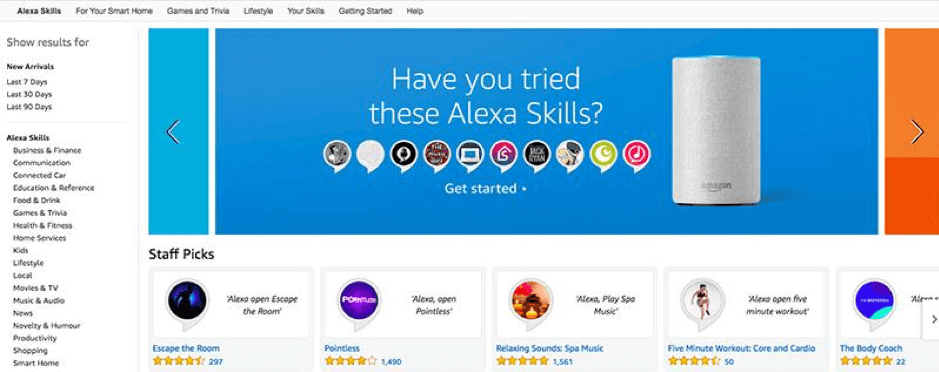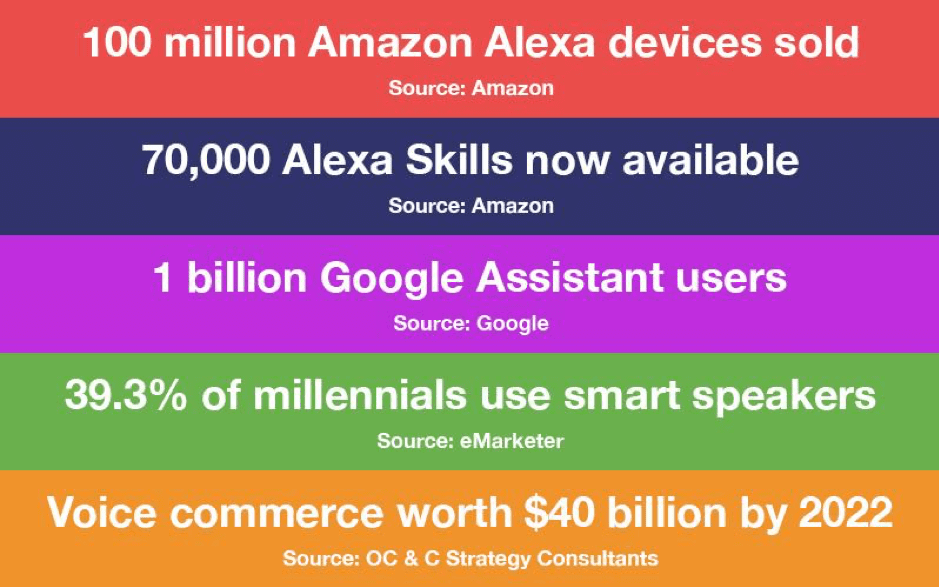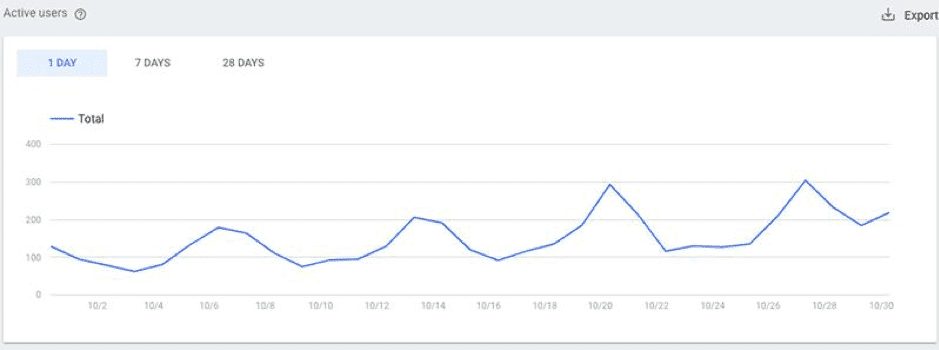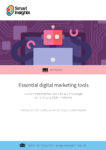Voice technology will be huge in 2019, with smart speakers driving this revolution. Let’s look at some of the key ways voice can boost marketing activity and engage audiences
A bit of background
Voice technology uses Natural Language Processing (NLP) and AI to provide a more intuitive way of interacting with devices including smart speakers. Although the underlying technology has been in development for decades, it is only with recent advances in computing that it has been practical and reliable.
Now let’s take a brief look at the main smart speaker platforms.
Download our Free Resource – Essential digital marketing tools
This guide gives Free members a preview of the 30 categories of digital marketing tools you should be using for your marketing.
Access the Essential digital marketing tools
Amazon Alexa
Currently the most popular smart speakers with global sales of 100 million devices. Alexa technology is available in a wide range of devices from the entry level Echo Dot through to screen-based Echo Spot and Echo Show devices. Crucially, Amazon also licenses the technology to other manufacturers, so it is platform agnostic. Alexa has recently been made available for Windows 10, Xbox consoles and even a microwave oven.
Additional capabilities can be added to Alexa devices via Skills. These are small applications that can be enabled and there are now over 70,000 available. The UK Skills Store has a very active developer community, with progressive brands now beginning to enter this space.

Amazon enjoyed a first to market advantage, with Alexa now seen as the de facto smart speaker by many consumers.
Google Assistant
A key focus of Google’s approach is the tight implementation of advanced AI and search functionality. Assistant can be seen as the first step in a wider strategy including deep learning and the rollout of Duplex technology in the US.
Devices can receive new functionality via Actions and Google has wisely made these compatible with the Google Assistant app. This opens up smart speaker capabilities to a vast audience who don’t already own the devices. A recent statement from Google estimates this to be around one billion users. Google also recently announced that Assistant would be integrated with the Google Maps iOS app.
Google offers a range of smart speakers from the Google Home Mini to Google Home Hub. The technology is also increasingly being built into smart televisions and other appliances.
Apple Siri
The technology is available across all iOS devices and the HomePod. Although a capable personal assistant and audio player when used with Apple Music, Siri has a less active developer community of Amazon and Google.
Samsung Bixby
A more recent entrant to the market and designed primarily for Samsung hardware. Developers can build capsules that provide functionality.
Microsoft Cortana
Cortana is a well-established voice assistant, although the smart speakers have never sold in significant numbers, and in recognition of this Microsoft is now strategic partners with Amazon. This has led to Alexa integration with Windows and other Microsoft products.

Benefits of voice technology
Now let’s explore some of the reasons why voice technology is a great fit for innovative marketing teams.
Ease of use
Voice assistants are immediately intuitive and simple to use. Consumers don’t need to learn an interface or operating system, which greatly improves accessibility and opens up the market to a very wide audience. This includes senior demographics who have been frequently neglected by the smartphone and tablet era.
Massive potential audience
Unlike more niche technologies such as VR, smart speakers are already available in millions of homes. The Echo Dot was the top-selling item on the Amazon US and UK stores this December, with 50% of all searches being voice searches and Voice Shopping to reach $40 billion by 2022.
Cost-effective
The low cost of entry-level devices makes smart speakers an attractive proposition. Especially when compared to the much higher price points of smartphones and tablets.
Low barriers to entry
Amazon and Google are offering intuitive development tools, learning resources and financial incentives to create Skills and Actions. High-quality voice experiences can be created relatively straightforwardly by small teams using familiar tools including JavaScript.
The need to recruit developers with highly specialized skill-sets such as C and Java is not required, helping to reduce costs and shorten project timescales.
An emerging market
Voice technology is still an evolving medium, with the market being defined. This represents exciting opportunities to innovate and be first in a category.
Repurposing of existing content
As voice assistants provide audio and more recently video playback on some devices, it makes sense to extend the use of your current assets wherever possible.
Key functionality
Content curation
Smart speakers offer a convenient way to listen to radio, podcasts and news updates.
Alexa Flash Briefings provide daily or weekly updates and marketing teams can utilize existing feeds to power these.
The Guardian recently launched a quiz for Google Assistant based on news stories from 2018, and expect to see interactive news stories and features in the near future.
Podcasts may also benefit from interactivity and provide a more engaging listening experience.
Lead generation
Voice assistants can connect to a range of databases and CRM systems and allow for frictionless acquisition of personal data. It’s obviously early days although it is likely consumers may feel it is easier to provide contact information conversationally, rather than manually completing a form.
Obviously, there are some potential GDPR concerns to address, in terms of whether verbal consent to receive information is sufficient, although it is likely the ICO will issue guidance in due course.
Narrative and storytelling
This is an area in which smart speakers excel and is already being embraced by media disrupters.
HBO has invested heavily in an interactive Westworld game, with Netflix offering the opportunity to speak to characters from Stranger Things and Lost in Space.
In the UK, BBC R&D released the sci-fi comedy adventure The Inspection Chamber to positive reviews.
Interactive guides
Quizzes and games are very popular on smart speakers, and interactive guides are a great way to showcase your products and services.
For example, a conversational coffee guide could help engage consumers and provide additional value.
Immersive brand experiences
Being able to navigate products verbally or explore options at your own pace makes voice technology an excellent way to showcase products. Marketing teams can provide the feel of a personalized ad campaign without the potential drawbacks (concerns about privacy, individuals running ad blockers, etc).
Diageo launched an interactive whisky tasting Alexa Skill in December 2018 and expect to see more high profile brands deliver engaging brand campaigns over the coming year.
Purchasing
Although it is accurate to say that there have yet to be huge levels of purchases made directly from smart speakers, Amazon did report a three-fold increase in sales over the 2018 Christmas period.
Google Assistant recently provided a simple method of donating to charity using their devices, and this in many ways can be seen as a test run for increased payment integration.
Revenue generation
In-Skill Purchasing provides revenue streams for Alexa content. It typically works on a freemium level where specific content/services can be purchased. This is a useful tool for monetization when used sensibly.
Publishing process
Both Alexa Skills and Assistant Actions must go through a certification process before they are approved and available to all consumers. This is usually fairly straightforward and if changes are required detailed feedback is given.
Approval times do vary, although both companies aim to provide initial feedback within five working days. In practice, this is often longer particularly during busy periods and near month end.
Here are some tips to maximize your chances of approval:
- Provide detailed release notes:
Ensure developers give enough information to the certification team. Particularly in relation to features and testing approach.
- Never leave the microphone open:
Smart speakers are designed to only allow input for a period of eight seconds following a user prompt. If the microphone is left open at any other point the Skill or Action will be rejected.
- Use clear prompts:
When asking for user input always make it obvious what is required. A good approach is to avoid ambiguous or open-ended queries:Bad example
What can I help you with?Good example
What class would you like to book today? Spinning or Zumba
- Ensure you use the correct categories:
This may sound obvious but is worth double checking.
Voice strategy and metrics
Analytical and behavioural data is available for both platforms, although is fairly limited at the present time.

Having said this it is possible to obtain some useful data. In terms of KPIs tracking the following metrics are the most helpful:
- Active users
- Returning users
- Conversation length
- Abort/abandonment rate
- User journeys / conversational routes
The road ahead
Hopefully, this article has demonstrated that smart speakers offer a low-cost, high-impact marketing tool, so to round things off let’s see what we can expect over the next 12 months.
Multi-modal experiences
Smart speakers with screens are already available and APL (Alexa Presentation Language) was launched in October 2018 to support these new devices. APL enhances the voice experience with photos, visual layouts, video and HTML5 elements.
Google provides similar support through Surface Capabilities.
Contextual understanding
AI and machine learning have made significant progress, even in the four years since Alexa was launched. Expect smart speakers to become more attentive to nuance and the ebb and flow of conversations. This will be partly down to an improved understanding of context and that the devices will also be able to communicate with sensors and IoT (Internet of Things) devices.
Ambient computing
Just as voice technology is removing the need for physical interfaces and potentially reducing screen time we are seeing a wider shift towards ambient computing. This is where smart speakers, home appliances, our phones and other devices all seamlessly work together. Platforms become less relevant than the tasks we are trying to accomplish, with the forthcoming rollout of 5G avoiding network connectivity and bandwidth capacity issues.
In a recent interview with The Verge, Amazon’s Senior Vice President of devices and services, Dave Limp, stated, "We have a very singular focus on this idea of an ambient user interface and where that makes the most sense."
New players
Although Amazon and Google dominate the current smart speaker market, there will likely be increased competition from companies including Alibaba. Unlike previous format wars such as VHS vs Betamax, multiple smart speakers will coexist with consumers benefiting from the rapid iteration of devices and new features.
Rich Ashby is the Founder of
Dotkumo and has worked in digital content for over 20 years. He regularly consults on voice technology, social media, web development and video. Recent projects include campaigns for NOW TV, Netflix, Leeds International Piano Competition, Campus PR, Pancreatic Cancer Research Fund and the University of East Anglia.











